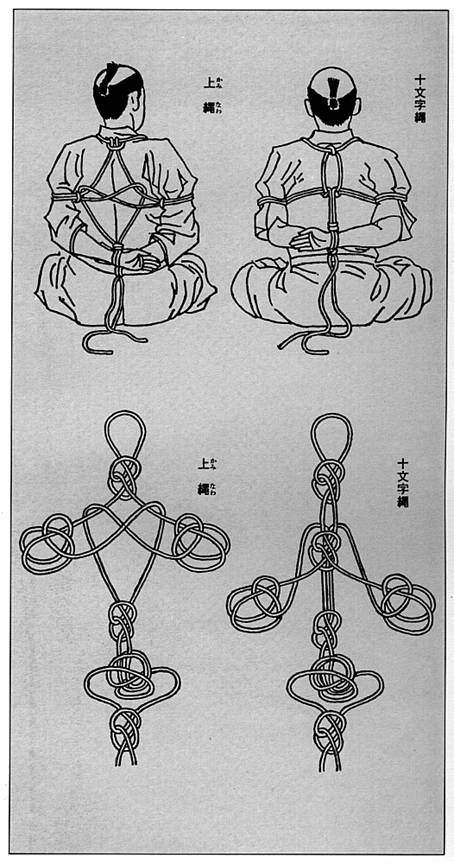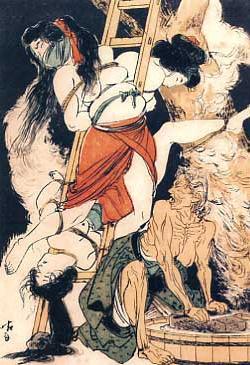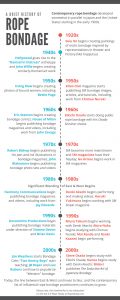A Brief History of Rope Bondage
When we talk about “rope bondage,” there are many things that we could mean: everything from tying your partner to the bedposts to intense forms of restriction and contortion to intricately-woven rope patterns. These roughly correlate to the three main styles of rope bondage: Western, Eastern (primarily Japanese), and decorative. This section will provide an overview of what those terms mean and where these influences originated.
Contemporary rope bondage gets its start in the early 1900s, and both Japanese and Western rope bondage develop in parallel into the 2000s. We don’t mean to suggest that no one ever tied anyone up for sexual enjoyment before that time. However, in terms of tracing any type of direct lineage, the thread seems to start around that time.
When we examine the history of rope bondage in the East, we find that much of what we see in contemporary rope bondage traces its origins to Japanese culture. Rope has long played an important role in Japanese sacred traditions. In addition, the practice of capturing and restraining suspected criminals with rope (often called “hojojutsu”) can be traced back through early Japanese history. In particular, the Edo Period is associated with more elaborate schools of hojojutsu and the use of various torture techniques involving rope. However, there is no suggestion that any of these practices were sensual or erotic in the way that we think of modern rope bondage. Also, while some early Japanese rope practitioners admit that they drew inspiration from hojojutsu, there does not appear to be any direct lineage from early hojojutsu to modern-day shibari.
The development of modern shibari or kinbaku, with its sensual/erotic or sado/masochistic tendencies, is generally traced to the work of Seiu Ito, an artist who incorporated rope bondage into his erotic works early in the 20th century. His work inspired others, and that growth and evolution led to the work of contemporary Japanese rope artists such as Osada Eikichi, Akechi Denki, Nawashi Kanna, Chimuo Nureki, Akira Naka, Yukimura Haruki, Kazami Ranki, Randa Mai, Arisue Go, and others. Japanese rope bondage is often referred to using the terms shibari (which roughly translates as “to tie”) or kinbaku (which roughly translates as “to bind tightly or with force”), and even though both terms mean approximately the same thing and are often used interchangeably, it has become somewhat common of late to use “shibari” to mean any form of Japanese-inspired rope bondage and “kinbaku” to mean Japanese-inspired rope bondage that specifically has elements of sensuality, sexuality, shame, or submission (though arguing over these terms is certainly a waste of time).
In the West, we can trace the origins back to Hollywood and the “damsel in distress” archetype starting as early as 1914. By the 1940s, that archetype was being used as a regular plot device. Around the same time, John Willie began to create erotic artwork and photography involving rope bondage that would influence many future rope artists. In the 1950s, Irving Klaw started doing the same, and one of his most popular models was the well-known Bettie Page. The “pin-up” genre of artwork expanded this archetype, and burlesque shows and detective magazines featuring captured and bound females continued to broaden the exposure and appeal of these kinds of images.

Diagrams of Hojojutsu Bindings 
Ito’s drawing depicting an onibaba and her victims. Inspired by Yoshitoshi. 
Artwork by John Willie
Throughout this period in the West, there was undoubtedly some crossover and influence from Japanese bondage. Many will argue the extent of the influence or the precise points of crossover, but few will deny it completely. However, despite these mutual influences, Japanese and Western rope bondage retained unique characteristics that still distinguish them as different styles of rope bondage art. We’ll take a closer look at these distinctions in the next section.
- The Kinbakunomicon podcast (particularly “Introduction” and “Wherefore Art Thou Kinbaku“)
- Master K’s The Beauty of Kinbaku (Website | Amazon)
- Midori’s The Seductive Art of Japanese Bondage
- “History & Style: East vs. West”
- “The History & Myths of Japanese Bondage”
